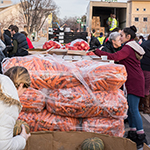
During this episode of the Cooking with International Programs series, CSU alum Guarav Harshe shares one of his favorite Indian sweet treats: puran poli, which is a flatbread stuffed with sweet lentil filling. If you’re looking for desserts from around the world, this is sure to satisfy your sweet tooth! You can watch this video here.
Launched in April 2020, the cooking demo series provides staff and students in the Office of International Programs a chance to share a bit of their culture with the Ram family. Currently, there are eight videos ranging from making pasta in Italy to Chinese sweet and sour pork.
If you’d like to watch any of the videos in the series, check out: www.youtube.com/user/CSUInternational
Making Puran Poli by Chef Guarav
Ingredients
- 250 grams or 1 1/4 cups Chana Daal
- 250 grams or 1 1/4 cups sugar
- 500 grams or 4 cups all-purpose flour (plus some for dusting)
- 6 teaspoons cardamom (as needed)
- 2 teaspoons nutmeg
- water (as needed)
- ghee or oil (as needed) – see tip at the end if you don’t have ghee or can’t find any
Directions
For Puran (sweet filling):
- Rinse the chana dal very well in hot water. Soak the chana dal for about an hour and then drain the water. Soaking is optional but suggested.
- In a pressure cooker, cook the chana dal for 6 to 7 whistles or about 20 minutes. Chana daal is hard to cook so be patient with it. If you soak the chana dal, the cooking time will be reduced. Once the pressure settles down on its own, strain the cooked dal very well, using a colander if you have one. If you don’t have a pressure cooker, you can cook the chana daal, but it will take a bit longer. Cook on medium heat, covered, for several hours.
- Add the chana dal and sugar in a non-stick stockpot. Stir continuously and let this puran mixture cook on a low flame till the mixture becomes dry and one piece.
- Once the puran stuffing becomes dry and thick, turn off the heat.
- Let it cool and then mash the puran mixture with a potato masher (or grind it in a fine paste/powder with a blender). Set aside.
For Poli Dough:
- While the puran is cooling off, put flour and a pinch of salt in a bowl, and mix well.
- Mix a little bit of water and ghee/oil into the flour. Begin to knead the dough slowly adding water as required. It will soak up a lot of water, almost the same amount as the flour.
- The dough should be smooth and soft, not stiff or hard. Cover and keep the dough aside for 30 minutes if soft, 1.5 hours if stiff.
- For making the puran poli:
- Take a 2-inch diameter size ball from the dough. Make a little dent in the ball so that you can place the filling in.
- Place a 2-inch diameter rounded portion of puran mixture in the center of the rolled dough.
- Bring the edges together towards the center. Join all the edges and pinch them on the top. Try to evenly surround the filling with the dough.
- Keep dusting with some flour while bringing the edges together so the dough doesn’t stick to your hands as much.
- Generously dust the area where you will roll out the ball with some flour and place the ball down, gently pressing the center with two fingers.
- Start flattening the ball using a rolling pin slightly in one direction while shifting the direction and making a + (plus) sign. The ball will start looking more like a rounded shape. Dust the top to help with rolling as the filling gets more and more exposed.
- Make a medium or large circle (poll) depending upon the size of the dough and puran filling you took. The thickness should be around the same as a thin tortilla and the size should be similar to a spread-out palm.
- Gently pick up the rolled-out circle and place it on a pan or griddle on medium heat.
- When one side has some bubbles in it and you smell a cooked aroma, turn over once and cook the other side until you see some brown spots or for about a minute. The poll doesn’t take a lot of time to cook so be careful with the heat setting and keep switching between medium and low. The poli is very delicate, flipping more than once can lead to breakage and overcooking.
- Once the second side is cooked and browned, remove it from the pan and place it on a plate and smear ghee/butter generously (Chana daal is hard to digest so ghee/butter helps).
- Make all puran polis this way and stack them over each other and place them in an airtight container.
You can serve puran poli warm, microwaved or at room temperature with either milk or more ghee!
Quick and easy tip to make your own amazing ghee at home:
Put some unsalted butter sticks in a pot and heat on the lowest heat possible for about an hour until the butter goes from light yellow to a dark brown. You will see the fats separate and form a layer of foam on the top, but resist the urge to stir or handle the pot.
Let it sit on the low flame, undisturbed, for about an hour and strain the ghee with a fine mesh strainer. Once the ghee settles and hardens, it will have a greyish brown color and a rather soft texture.



































































































